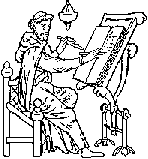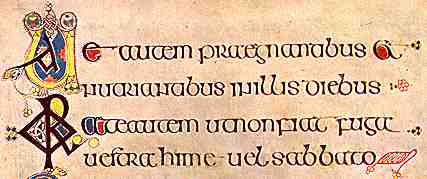



If you are looking at this page without frames, there is more information about medieval writing to be found by going to the home page (framed) or the site map (no frames).
| The Concept of Text in the Manuscript Tradition | ||||
| There is a popular conception of the process of textual copying in the medieval period, in which it is envisioned that serried ranks of copyist scribes, often perceived as monks, painfully reproduced in exact detail multiple copies of standard works. Variants in the text produced are counted as errors, and they mounted up to haunt less diligent scribes in Purgatory. This is only partly true, for certain texts and for certain parts of the medieval era. For the great majority of texts, variation, compilation and innovation combined to produce, not just one text, but a family of related texts, varied to suit different needs and, in many cases, endlessly additive. |  |
|||
| The way we treat medieval texts in modern scholarship says much about our own mindset, locked into the industrial mode of book production which allows for only one correct version of a text. Definitive printed editions are produced of works which originated in manuscript, utilising meticulous scholarship to arrive at what is perceived to be the most correct version. Variants may be intricately analysed to provide evidence for the chains of copying that spread the work across the landscape and through different societies, but there is a sense that the original version of a text, if it can be teased out, is the authentic one. In the medieval manuscript tradition, variants were created to serve particular purposes, and each was authentic in its own context. | ||||
| Some modern studies which have escaped the limitations of the printed page into the greater latitudes of cyberspace have attempted to examine variants of certain texts. these include The Charrette Project, The Piers Plowman Electronic Archive, Le Roman de la Rose and The Planctus for William Longsword. Even in ye olde print media Dorothy Whitelock (Ed.) 1979 English Historical Documents c.500-1042 London: Eyre Methuen and New York: Oxford University Press contains a complicated page layout showing the variants on the Anglo-Saxon Chronicle. | ||||
| The work that there was the most concern to standardise was the Bible, this being the authoritative text of Christianity, but even that was not fully standardised in the early centuries. Various Old Latin translations were gradually supplanted by St Jerome's Vulgate; a massive fresh translation from Hebrew and Greek texts. Jerome himself produced some variants, producing several translations of the Psalms which could appear in Vulgate texts in different times and places. | ||||
 |
A variant segment of the text of Mark xiii. 17-22, from from f.104r of the Book of Kells. (From Sir Edward Sullivan 1952 The Book of Kells London and New York: The Studio Publications.) | |||
| Even the structure of the Bible was not entirely finalised at one time. What are known as the Old Testament Apocrypha were books which were not included by Jerome as he could find no Hebrew texts for them. However, they were reinstated into the Bible by the authorities from Old Latin texts. The New Testament Apocrypha consist of texts which are not considered to be part of the canon of scripture, but which nonetheless exercised considerable influence on medieval Christian thought and art. Some of these appear in early Bibles, or in listings of the canon, from before the 8th century. | ||||
 |
The reforms of the Carolingian era involved not only producing texts of the Bible in the clear and legible Caroline minuscule script, but replacement of earlier variant texts with the standard Vulgate. This was not a rapid process, and the 11th and 12th centuries saw renewed efforts to provide accurate Bible exemplars for copying. | |||
| The Ada Gospels of the late 8th century (Treves, Stadtbibliothek, Bibelhandschriften 22 (Codex aureus), p.17). (From Steffens 1929) | ||||
 |
The early transcriptions were carried out by monks. Later, scribes from orders like the Augustinians may have been recruited into this work, because of their greater ability to travel around. By the 13th century, when the Dominicans and Franciscans were taking the message to a wider world, Bibles were produced for them by commercial booksellers. These had a highly standardised and compact format, and for the first time had all the books arranged in the same order, and divided into chapters. The evolution of this text was complete. However, look at any page and you may discover some minor variant of wording or spelling. This, I guess, is inevitable with such a long and verbose work, but who is to question its authenticity? | |||
| Segment from a 13th century portable Bible showing a chapter number, from a private collection. | ||||
| |
||||
If you are looking at this page without frames, there is more information about medieval writing to be found by going to the home page (framed) or the site map (no frames). |
||||